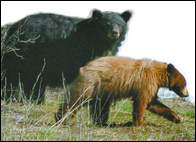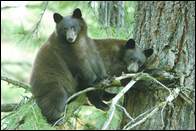
BEARSTahoe's black bears are awake early and they're hungry. That's not a good thing. What can you do? |
||
By Joanne Hartman April 20, 2007 |
 |
|
Alongside her trusty four-footed companion — Marvin, an 8-year-old porcupine — Ann Bryant instructs wide-eyed Glenshire preschoolers how to live in harmony with Tahoe-Truckee wildlife. “Marvin wanted me to tell you all thank you, and remember not to feed the bears and appreciate them. They’re one of our neighbors, too,” Bryant reminds the 4- and 5-year-olds as she picks Marvin up like a baby to place him back in his red wheelbarrow. With bear season quickly approaching, Bryant, founder and executive director of the BEAR League, gears up for another summer of frantic phone calls, bear chases and public education. “It seems like what’s happening every year: It starts out slow with sightings and grazing. As it gets into being summer season and visitors coming ... that’s when we start inviting the problem,” Bryant says. But the BEAR League has also received bear calls throughout the winter, a sign that fewer of the animals are opting to sleep through the colder months. Why? Because now food is readily available throughout the entire year, Bryant says. “Actually some bears never went in,” says Cheryl Millham, director of the South Shore-based animal rehabilitation organization, Lake Tahoe Wildlife Care. “They follow garbage.” And because this winter was a temperate one, the bears that did hibernate are already waking up. South Lake Tahoe and Alpine Meadows have already seen a lot of bear activity, says California Fish and Game wildlife biologist Jason Holley, but the brief cold spell will put the bears back down for just a bit. “Bear season is here again and everybody needs to take personal responsibility for their actions in bear country,” Holley says. BEAR League history “We all live in the forest, yes, but we have our homes,” she says. “They [the bears] have to respect our presence just like we have to respect their presence in the woods.” |
Be bear aware |
|
Bryant is assisted by a variety of creatures in her mission to save the bears, including Marvin the porcupine, her bear-chasing duo of Karelian bear dogs Dmytro and Anya and a team of local volunteers. “I was absolutely infuriated that this would happen to a resident of Tahoe,” Bryant says emphatically as she watches her dogs wrestle on a Tahoe beach near her Homewood home. |
A sow and her cub walk through a meadow off Highway 267 earlier this month. Emma Garrard/ Sierra Sun |
|
Two frightened bears survived the death of the mother bear, but one for only a minute. One cub was captured and killed while the other hid frightened in the trees. Bryant took in the orphaned cub, named him Oliver, and thus the BEAR League was born. “The main thing is not just to save the bears. Our mission is to educate people on how to coexist,” she says. |
||
Alex Close/ Sun News Service |
Improper garbage storage is illegal in both Placer and El Dorado counties, and homes where bears have broken into trash cans are required to purchase bear-proof containers. But people continue to leave homes and trash barrels unsecured. |
|
But depredation permits should be a last resort, say agency officials. |
||

